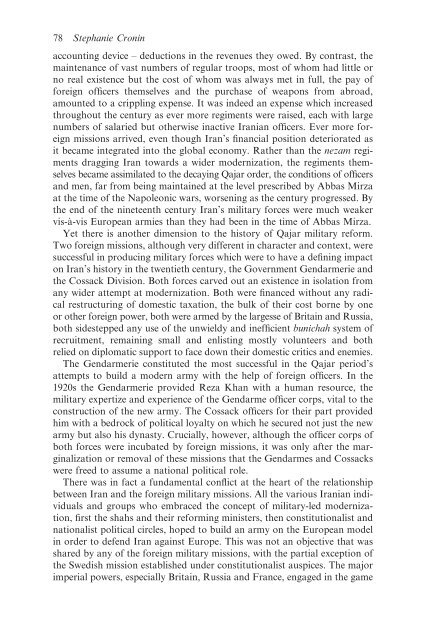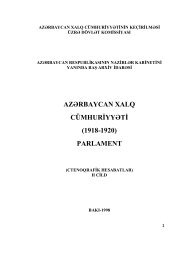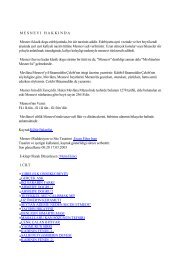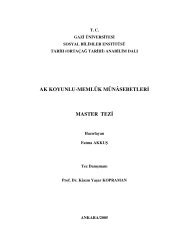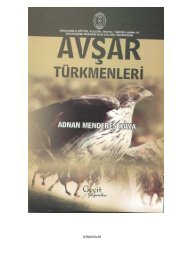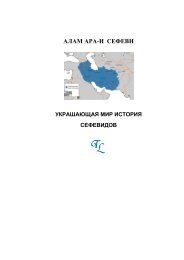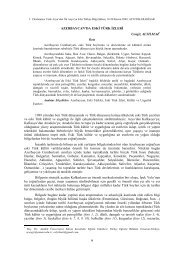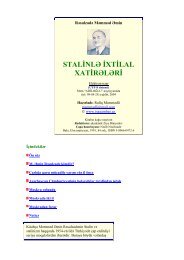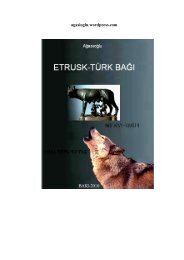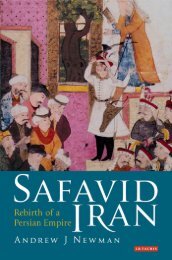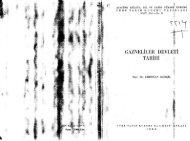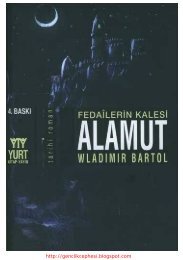War and Peace in Qajar Persia: Implications Past and ... - Oguzlar.az
War and Peace in Qajar Persia: Implications Past and ... - Oguzlar.az
War and Peace in Qajar Persia: Implications Past and ... - Oguzlar.az
- No tags were found...
You also want an ePaper? Increase the reach of your titles
YUMPU automatically turns print PDFs into web optimized ePapers that Google loves.
78 Stephanie Cron<strong>in</strong>account<strong>in</strong>g device – deductions <strong>in</strong> the revenues they owed. By contrast, thema<strong>in</strong>tenance of vast numbers of regular troops, most of whom had little orno real existence but the cost of whom was always met <strong>in</strong> full, the pay offoreign officers themselves <strong>and</strong> the purchase of weapons from abroad,amounted to a crippl<strong>in</strong>g expense. It was <strong>in</strong>deed an expense which <strong>in</strong>creasedthroughout the century as ever more regiments were raised, each with largenumbers of salaried but otherwise <strong>in</strong>active Iranian officers. Ever more foreignmissions arrived, even though Iran’s f<strong>in</strong>ancial position deteriorated asit became <strong>in</strong>tegrated <strong>in</strong>to the global economy. Rather than the nezam regimentsdragg<strong>in</strong>g Iran towards a wider modernization, the regiments themselvesbecame assimilated to the decay<strong>in</strong>g <strong>Qajar</strong> order, the conditions of officers<strong>and</strong> men, far from be<strong>in</strong>g ma<strong>in</strong>ta<strong>in</strong>ed at the level prescribed by Abbas Mirzaat the time of the Napoleonic wars, worsen<strong>in</strong>g as the century progressed. Bythe end of the n<strong>in</strong>eteenth century Iran’s military forces were much weakervis-à-vis European armies than they had been <strong>in</strong> the time of Abbas Mirza.Yet there is another dimension to the history of <strong>Qajar</strong> military reform.Two foreign missions, although very different <strong>in</strong> character <strong>and</strong> context, weresuccessful <strong>in</strong> produc<strong>in</strong>g military forces which were to have a def<strong>in</strong><strong>in</strong>g impacton Iran’s history <strong>in</strong> the twentieth century, the Government Gendarmerie <strong>and</strong>the Cossack Division. Both forces carved out an existence <strong>in</strong> isolation fromany wider attempt at modernization. Both were f<strong>in</strong>anced without any radicalrestructur<strong>in</strong>g of domestic taxation, the bulk of their cost borne by oneor other foreign power, both were armed by the largesse of Brita<strong>in</strong> <strong>and</strong> Russia,both sidestepped any use of the unwieldy <strong>and</strong> <strong>in</strong>efficient bunichah system ofrecruitment, rema<strong>in</strong><strong>in</strong>g small <strong>and</strong> enlist<strong>in</strong>g mostly volunteers <strong>and</strong> bothrelied on diplomatic support to face down their domestic critics <strong>and</strong> enemies.The Gendarmerie constituted the most successful <strong>in</strong> the <strong>Qajar</strong> period’sattempts to build a modern army with the help of foreign officers. In the1920s the Gendarmerie provided Reza Khan with a human resource, themilitary expertize <strong>and</strong> experience of the Gendarme officer corps, vital to theconstruction of the new army. The Cossack officers for their part providedhim with a bedrock of political loyalty on which he secured not just the newarmy but also his dynasty. Crucially, however, although the officer corps ofboth forces were <strong>in</strong>cubated by foreign missions, it was only after the marg<strong>in</strong>alizationor removal of these missions that the Gendarmes <strong>and</strong> Cossackswere freed to assume a national political role.There was <strong>in</strong> fact a fundamental conflict at the heart of the relationshipbetween Iran <strong>and</strong> the foreign military missions. All the various Iranian <strong>in</strong>dividuals<strong>and</strong> groups who embraced the concept of military-led modernization,first the shahs <strong>and</strong> their reform<strong>in</strong>g m<strong>in</strong>isters, then constitutionalist <strong>and</strong>nationalist political circles, hoped to build an army on the European model<strong>in</strong> order to defend Iran aga<strong>in</strong>st Europe. This was not an objective that wasshared by any of the foreign military missions, with the partial exception ofthe Swedish mission established under constitutionalist auspices. The majorimperial powers, especially Brita<strong>in</strong>, Russia <strong>and</strong> France, engaged <strong>in</strong> the game


